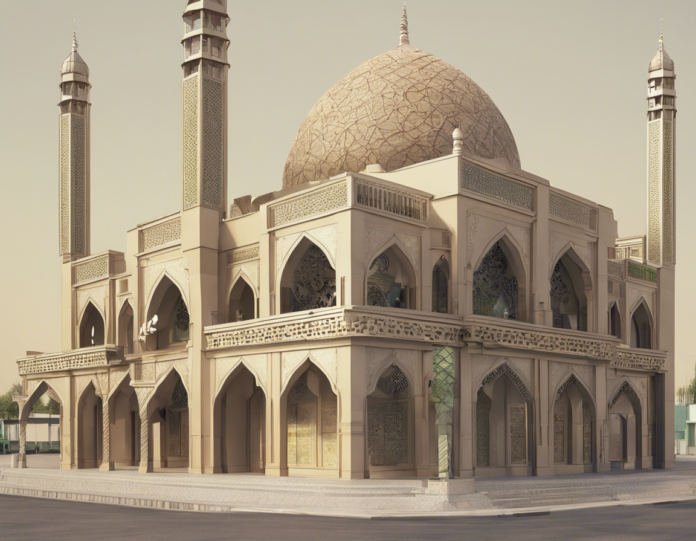Introduction
The Masjid Muhammad Bin Abdullah holds a significant place in the history of Islam as one of the first mosques built by Prophet Muhammad in Medina. More than just a place of worship, this mosque serves as a symbol of unity, faith, and resilience for the Muslim community worldwide. Let’s delve into the rich history and significance of Masjid Muhammad Bin Abdullah in this comprehensive article.
The Construction and Significance of Masjid Muhammad Bin Abdullah
The construction of Masjid Muhammad Bin Abdullah, also known as the Prophet’s Mosque, began in 622 AD under the supervision of Prophet Muhammad himself. The mosque was built to serve as a focal point for the growing Muslim community in Medina and as a place for congregation, prayer, education, and social gatherings.
One of the most notable features of Masjid Muhammad Bin Abdullah is the qibla, the direction Muslims face during prayer. Initially, the mosque’s qibla faced towards Jerusalem, but it was later changed to face the Kaaba in Mecca, aligning with the religious beliefs of the Muslim community.
Expansion and Renovation
Over the centuries, Masjid Muhammad Bin Abdullah has undergone several expansions and renovations to accommodate an increasing number of worshippers and to preserve its historical and architectural significance. The Ottoman Empire, in particular, played a crucial role in expanding and beautifying the mosque during their rule.
The Green Dome that covers the tomb of Prophet Muhammad is one of the most iconic features of Masjid Muhammad Bin Abdullah. The dome was constructed in the 16th century and symbolizes the connection between heaven and earth, serving as a focal point for pilgrims and visitors.
Pilgrimage and Spiritual Significance
Masjid Muhammad Bin Abdullah holds immense spiritual significance for Muslims around the world. It is the second holiest site in Islam, after the Masjid al-Haram in Mecca, and is considered a must-visit destination for pilgrims performing the Umrah or Hajj.
The act of visiting Masjid Muhammad Bin Abdullah is believed to bring numerous spiritual blessings and rewards, and it is a deeply enriching experience for those seeking spiritual fulfillment and connection with their faith.
Impact on Islamic Architecture
The architecture of Masjid Muhammad Bin Abdullah has influenced Islamic architectural styles across the globe. The mosque’s hypostyle hall, with its rows of columns and arches, has inspired the design of numerous mosques and Islamic buildings, showcasing the beauty and grandeur of Islamic architecture.
The intricate calligraphy and geometric patterns adorning the walls and domes of Masjid Muhammad Bin Abdullah are a testament to the artistic and cultural significance of Islamic architecture, reflecting the rich heritage and traditions of the Muslim world.
Preservation and Conservation Efforts
In recent years, there has been a growing emphasis on the preservation and conservation of Masjid Muhammad Bin Abdullah to safeguard its historical and cultural significance for future generations. Various initiatives and projects have been undertaken to restore and protect the mosque’s architectural integrity while ensuring its accessibility to visitors and worshippers.
Conclusion
Masjid Muhammad Bin Abdullah stands as a testament to the enduring legacy of Prophet Muhammad and the profound impact of Islam on art, culture, and architecture. Its rich history, spiritual significance, and architectural beauty continue to inspire and captivate people from all walks of life, making it a symbol of unity and faith for Muslims worldwide.
Frequently Asked Questions (FAQs)
1. What is the significance of the Green Dome at Masjid Muhammad Bin Abdullah?
The Green Dome covers the tomb of Prophet Muhammad and symbolizes the connection between heaven and earth, attracting pilgrims and visitors seeking blessings and spiritual fulfillment.
2. Why was the qibla direction at Masjid Muhammad Bin Abdullah changed?
The qibla direction was changed to face the Kaaba in Mecca to align with the religious beliefs of the Muslim community and to establish a unified direction of prayer for all Muslims.
3. How has Masjid Muhammad Bin Abdullah influenced Islamic architecture?
The mosque’s architectural features, such as the hypostyle hall and intricate calligraphy, have inspired Islamic architectural styles worldwide, showcasing the beauty and grandeur of Islamic art and design.
4. What spiritual benefits are associated with visiting Masjid Muhammad Bin Abdullah?
Visiting the mosque is believed to bring numerous spiritual blessings and rewards, offering a deeply enriching experience for pilgrims and worshippers seeking spiritual fulfillment and connection with their faith.
5. How has Masjid Muhammad Bin Abdullah been preserved and conserved over the years?
Various initiatives and projects have been undertaken to preserve the mosque’s historical and cultural significance, ensuring its architectural integrity while making it accessible to visitors and worshippers for generations to come.








